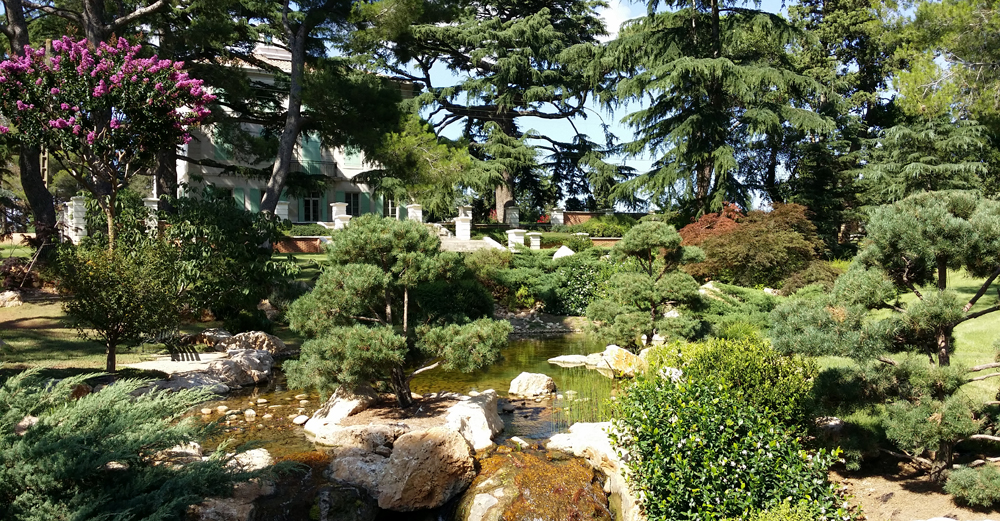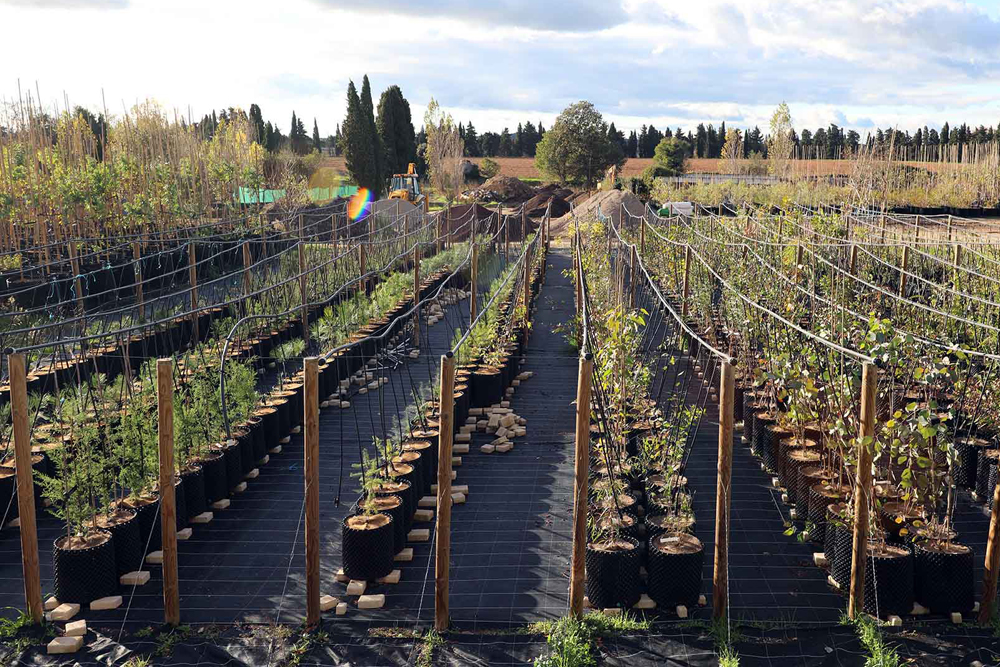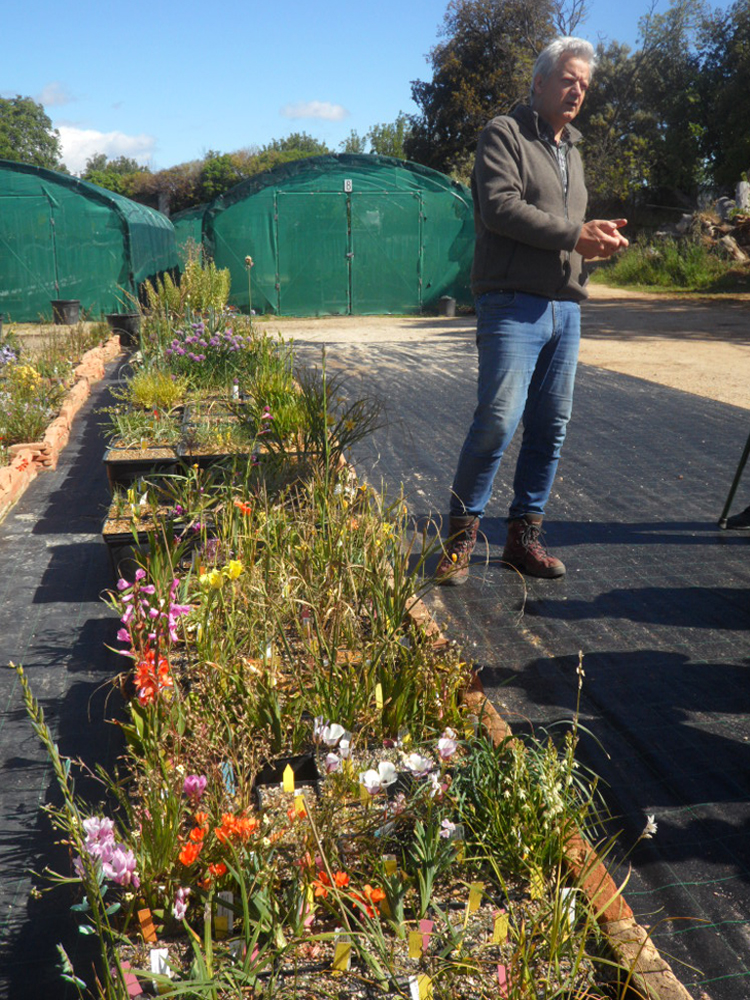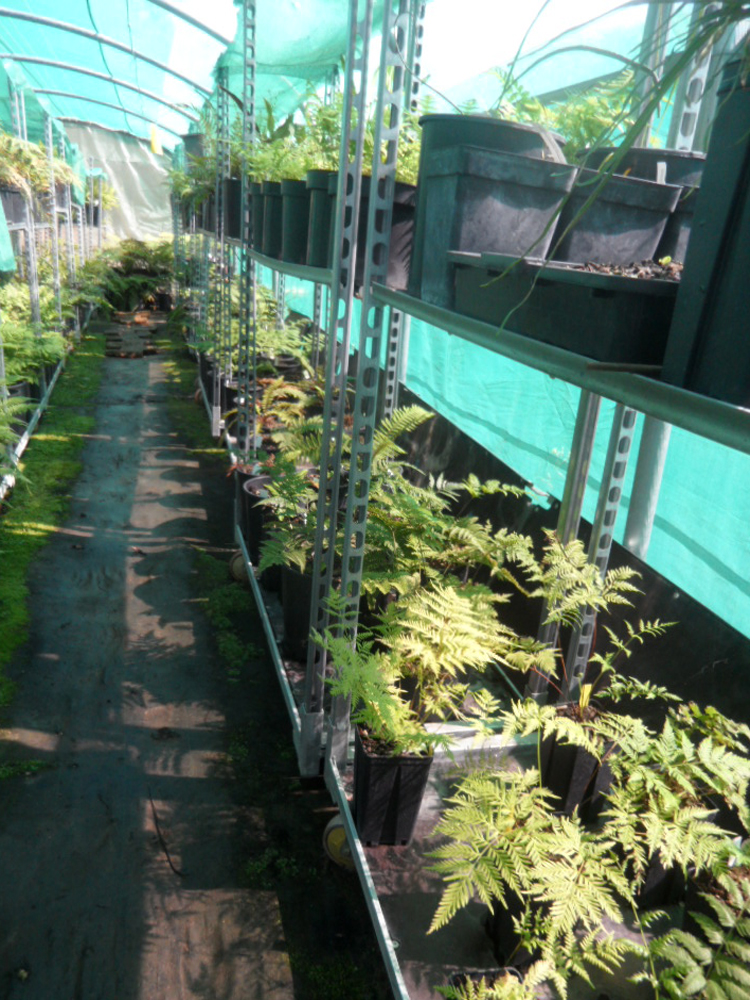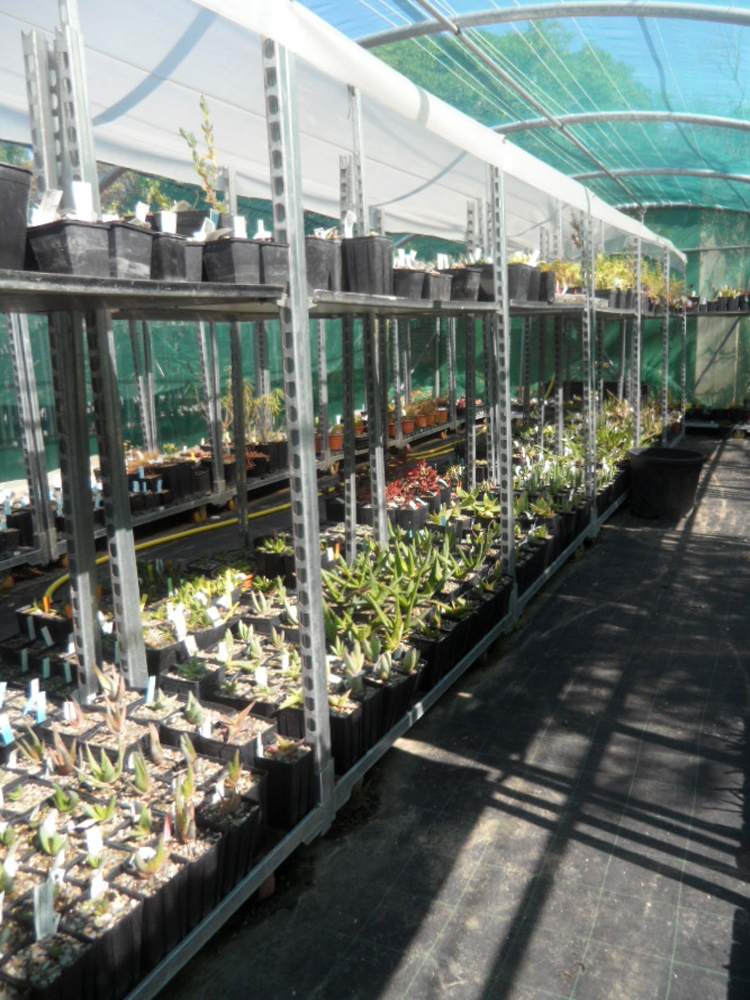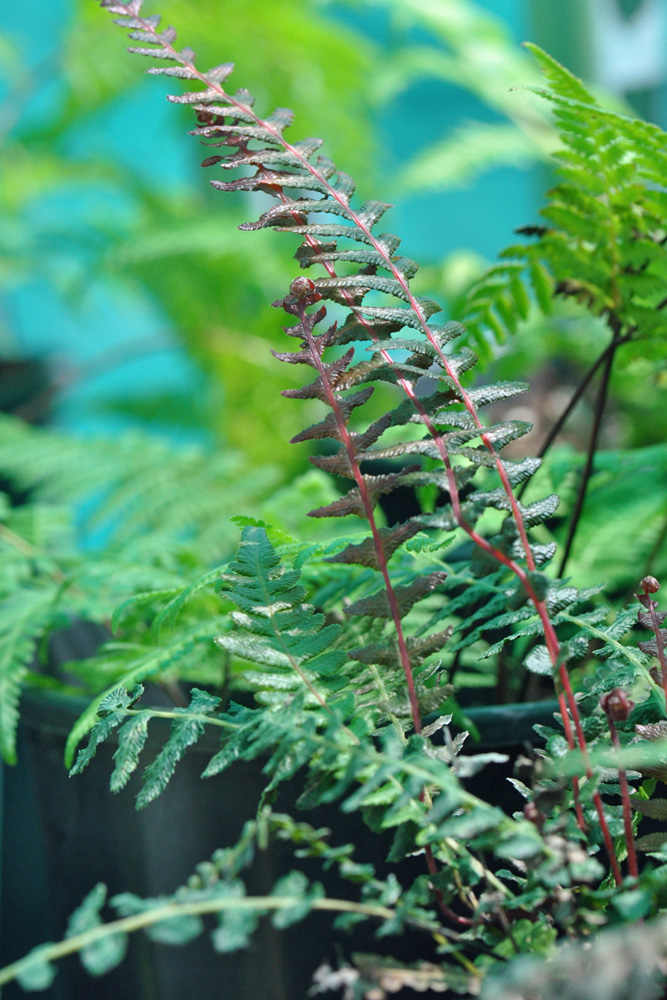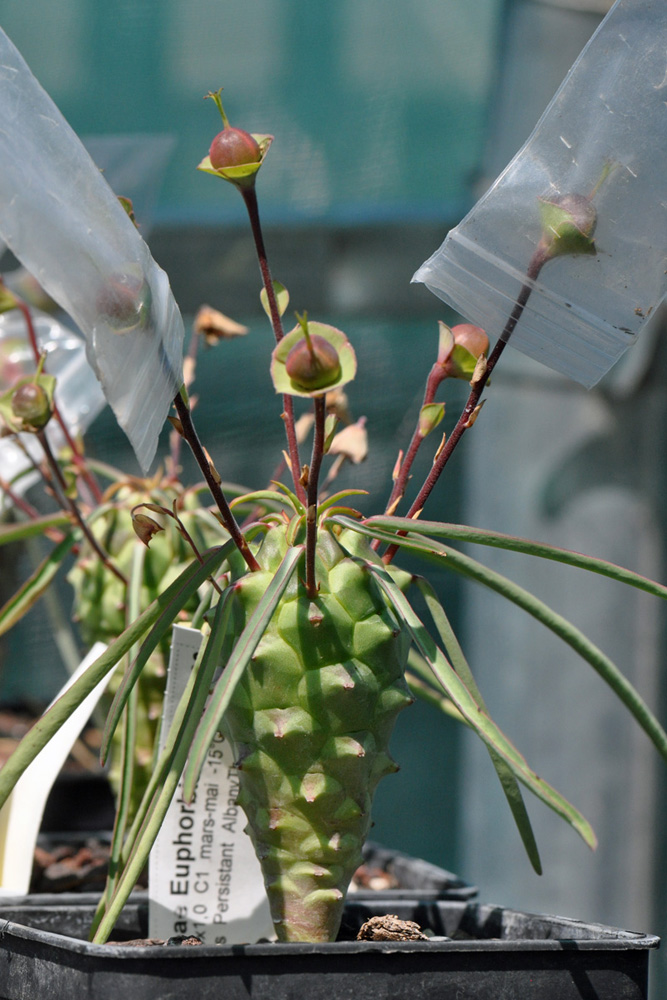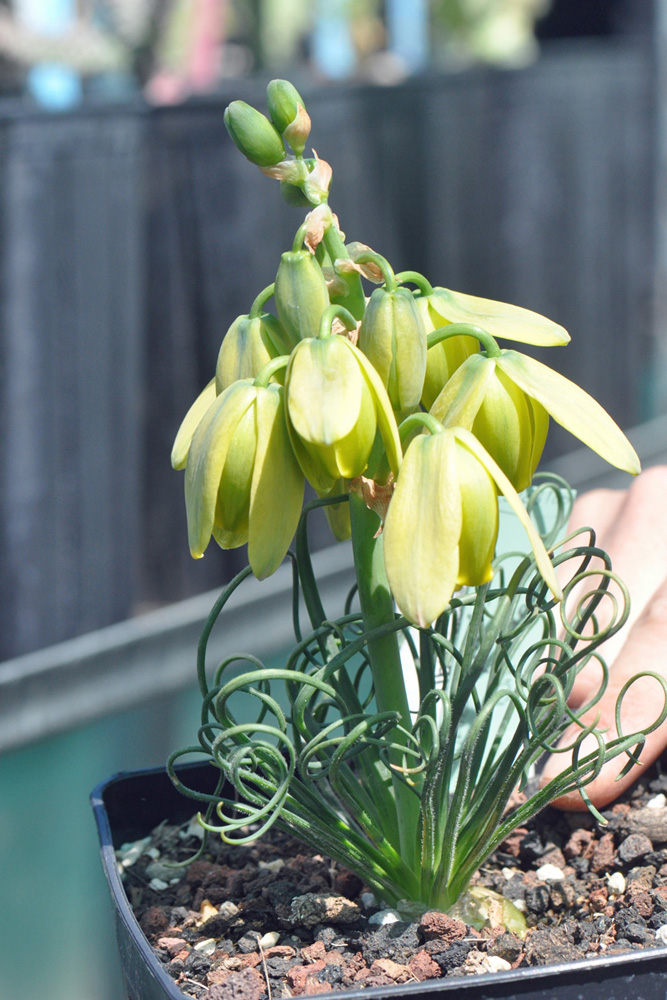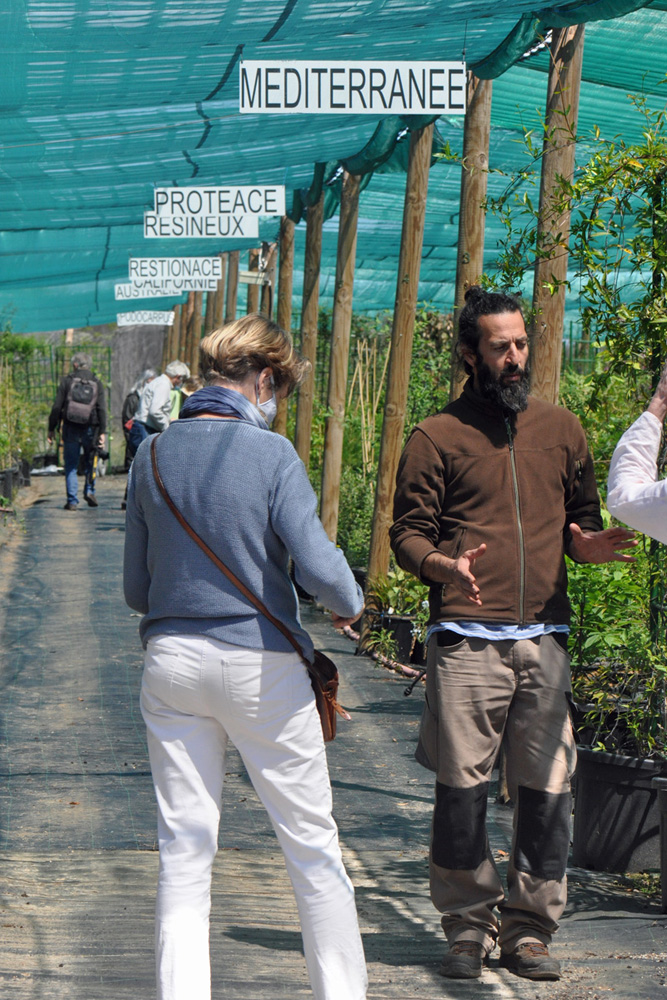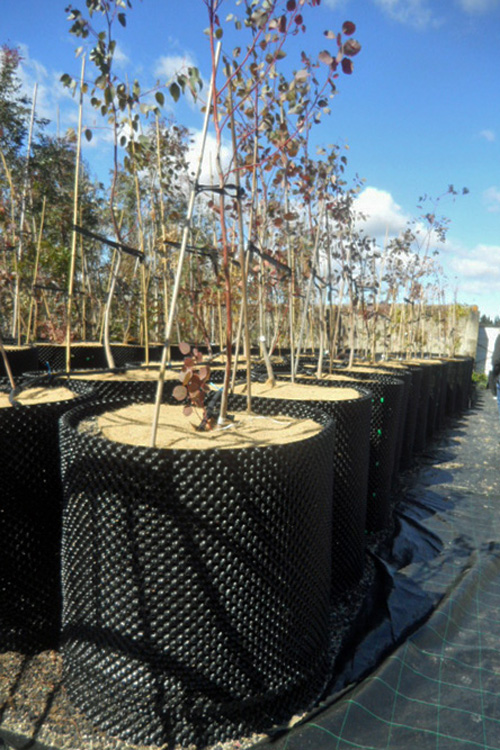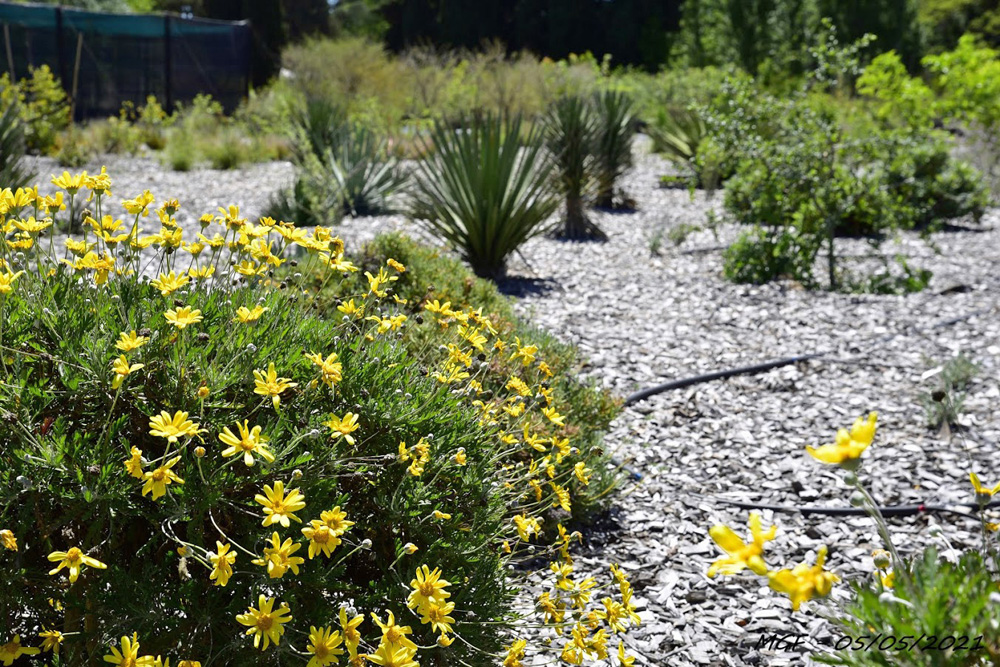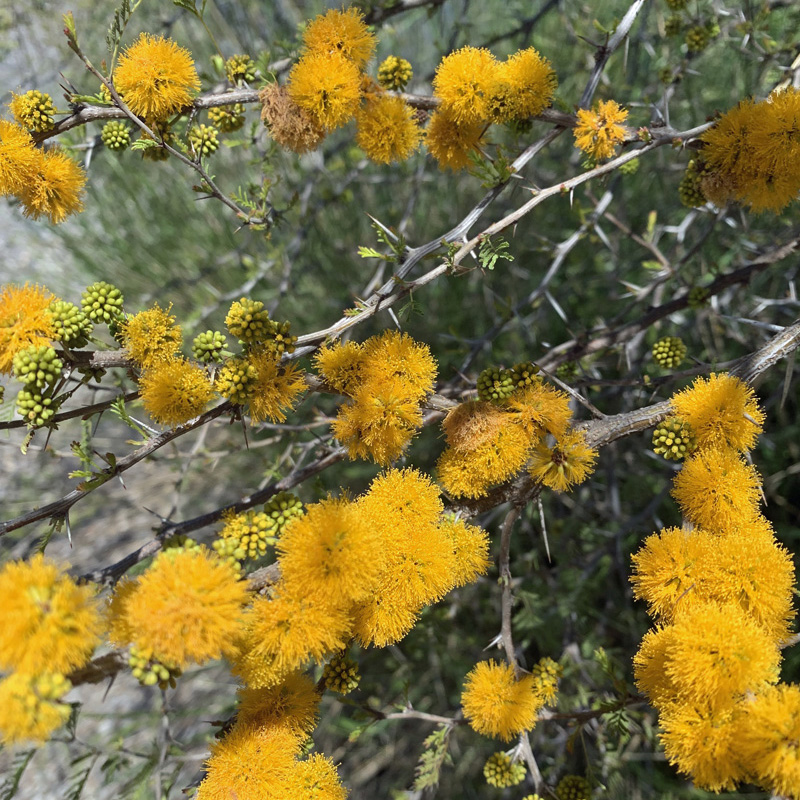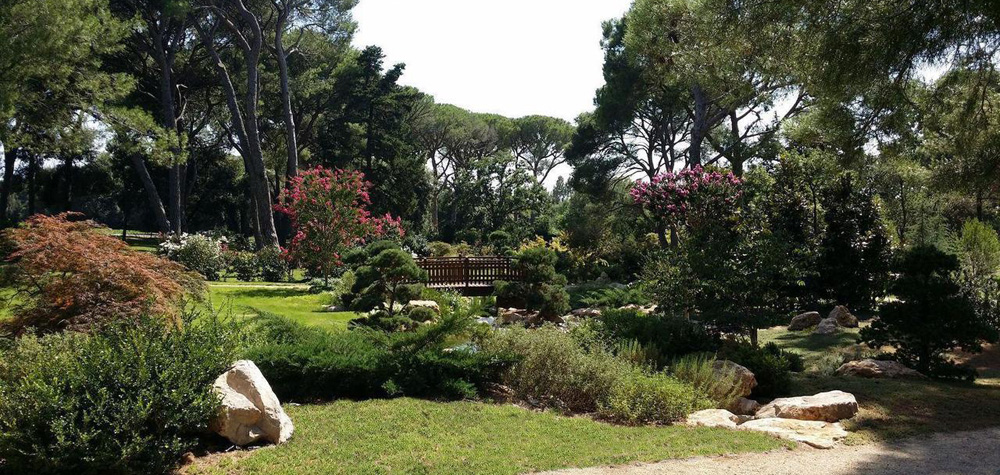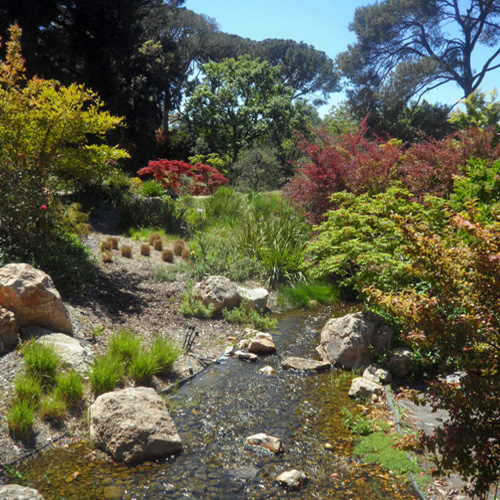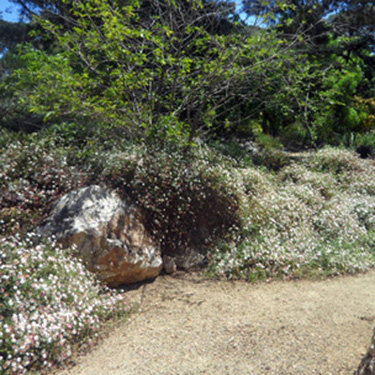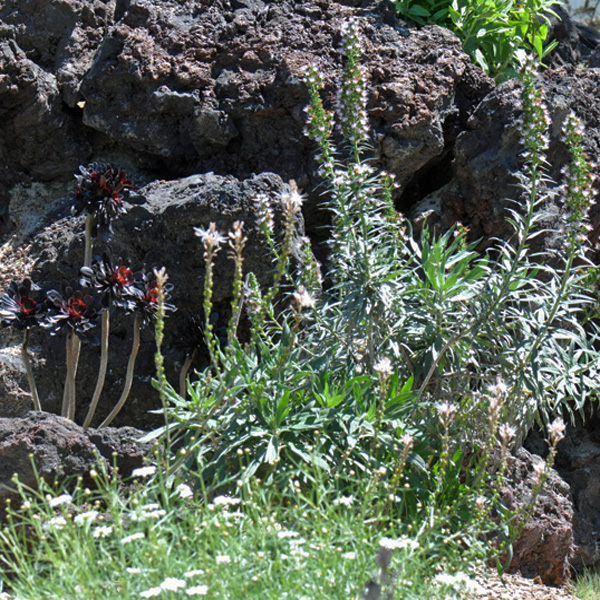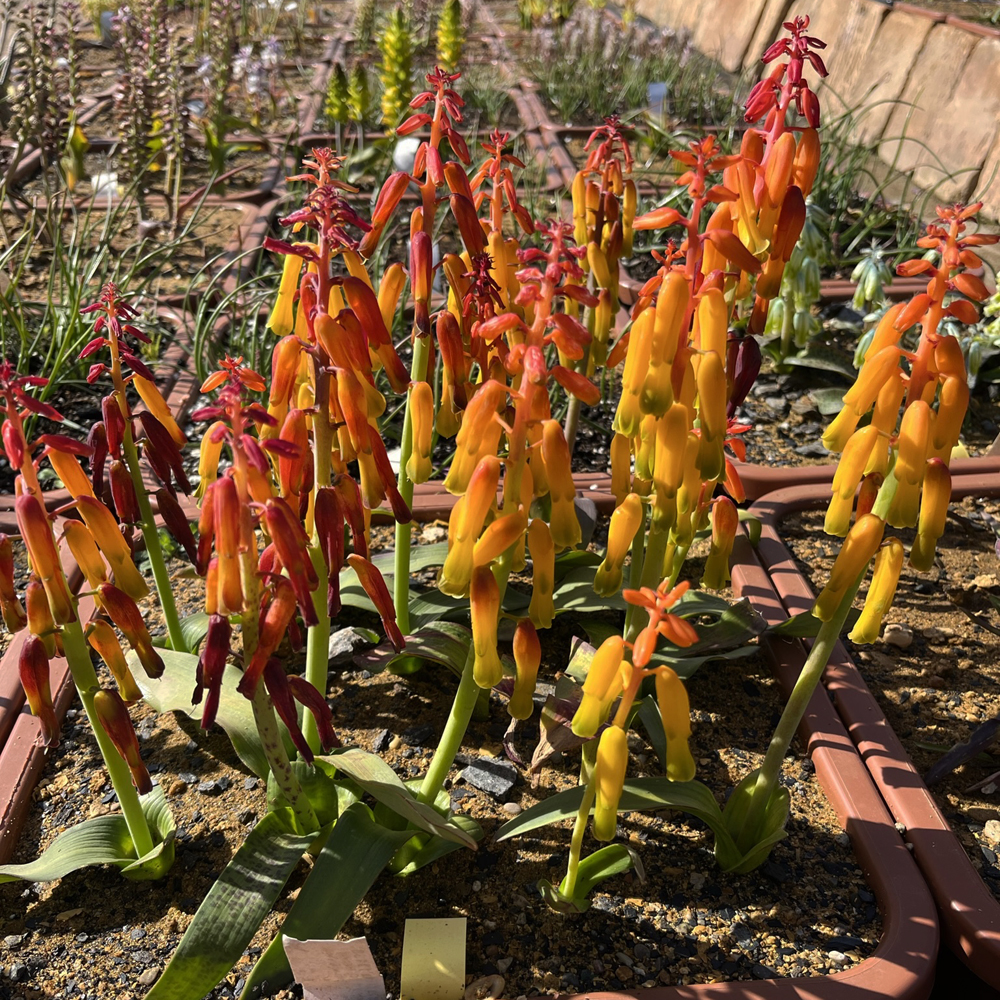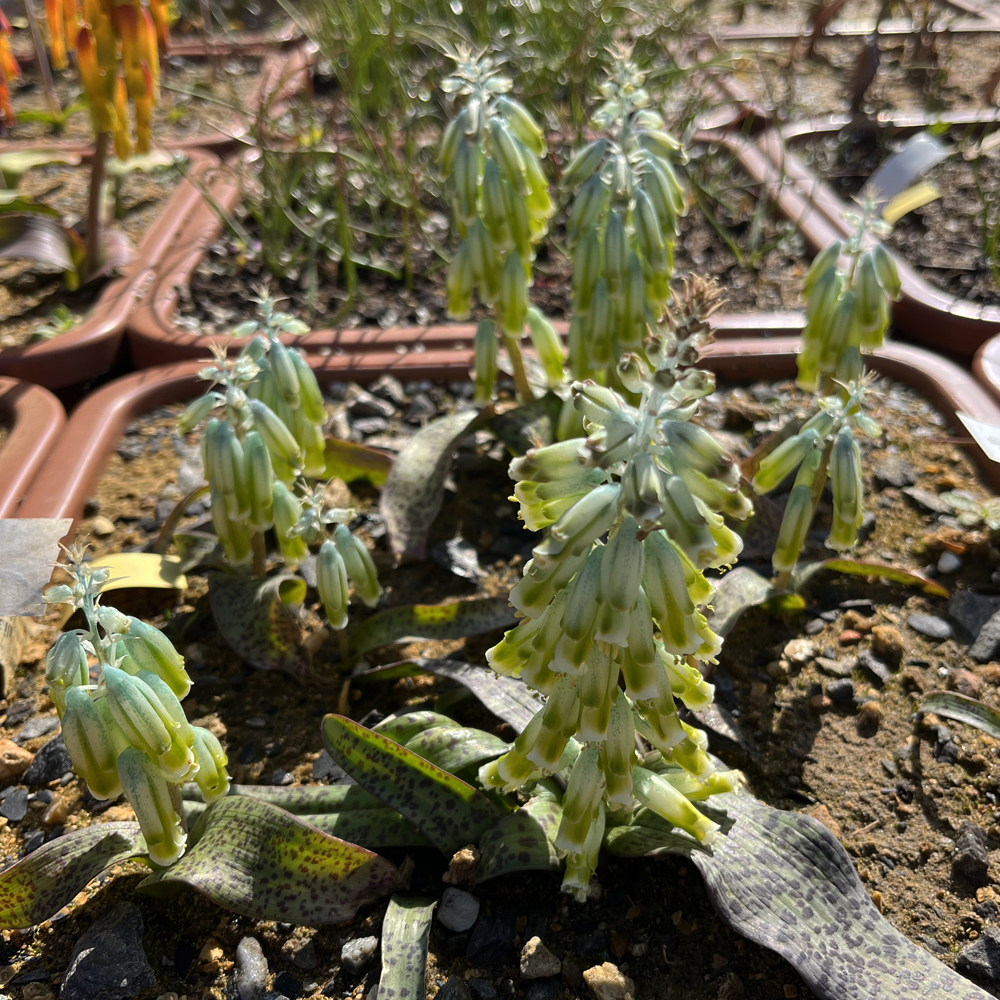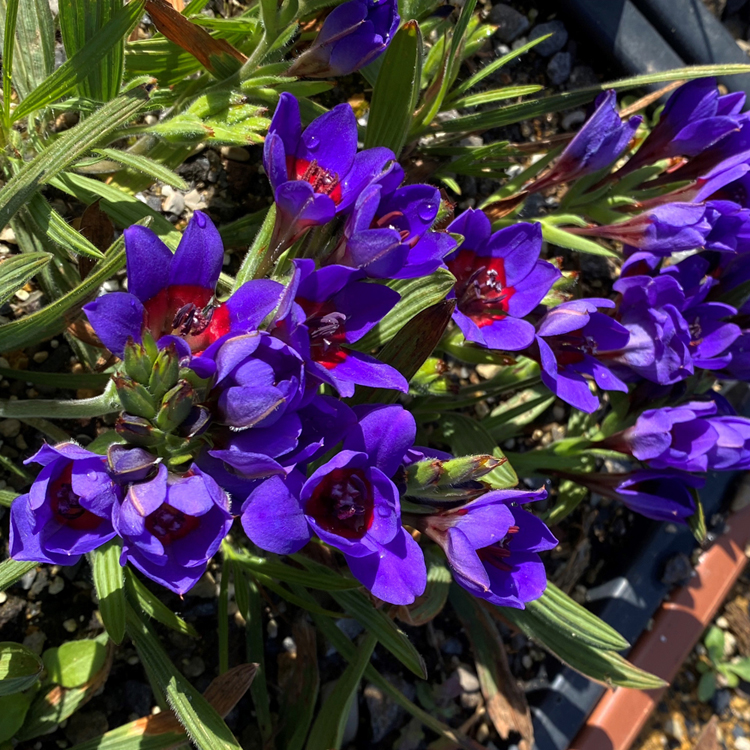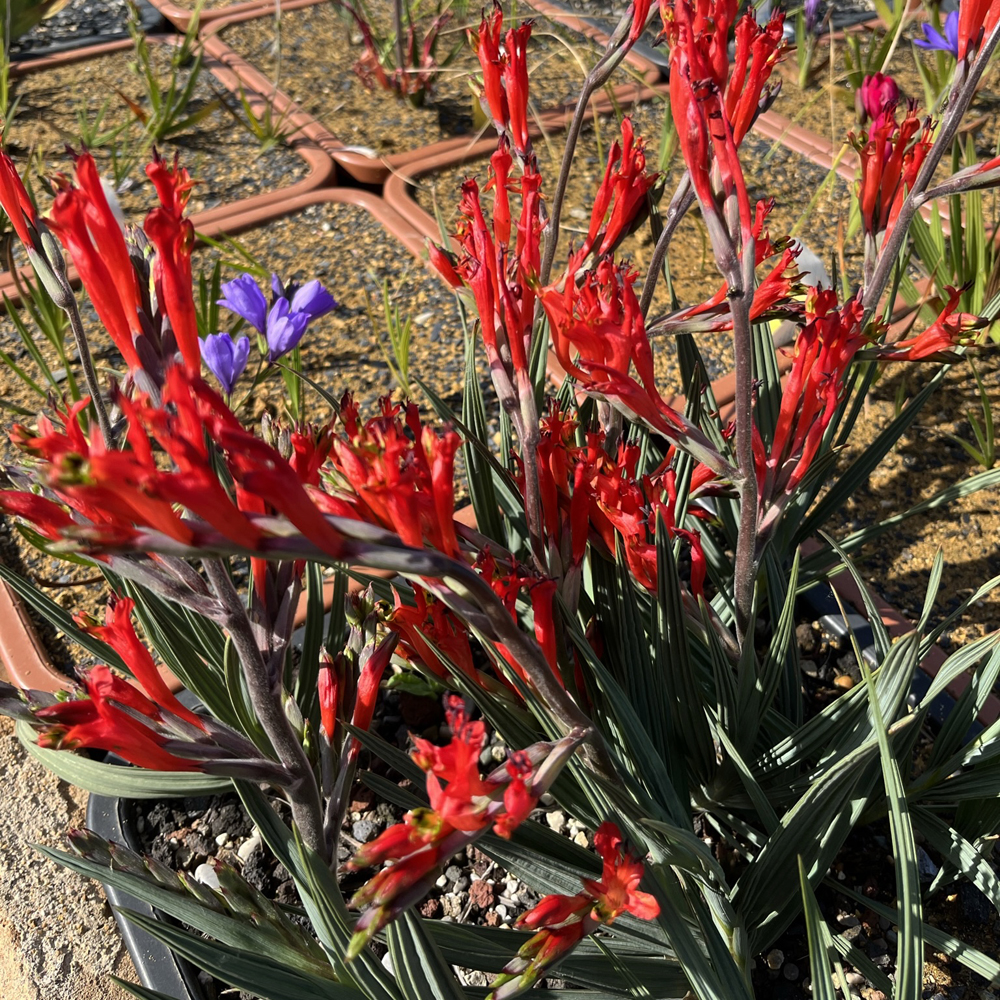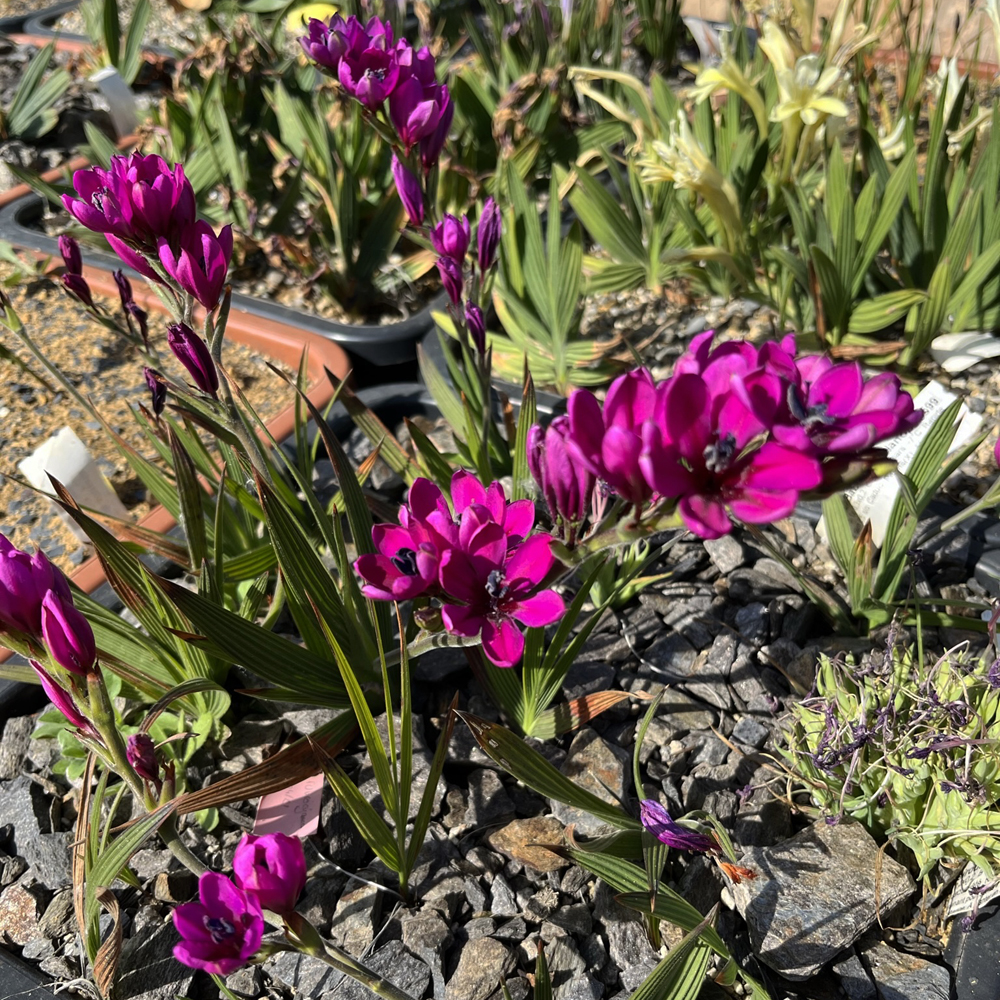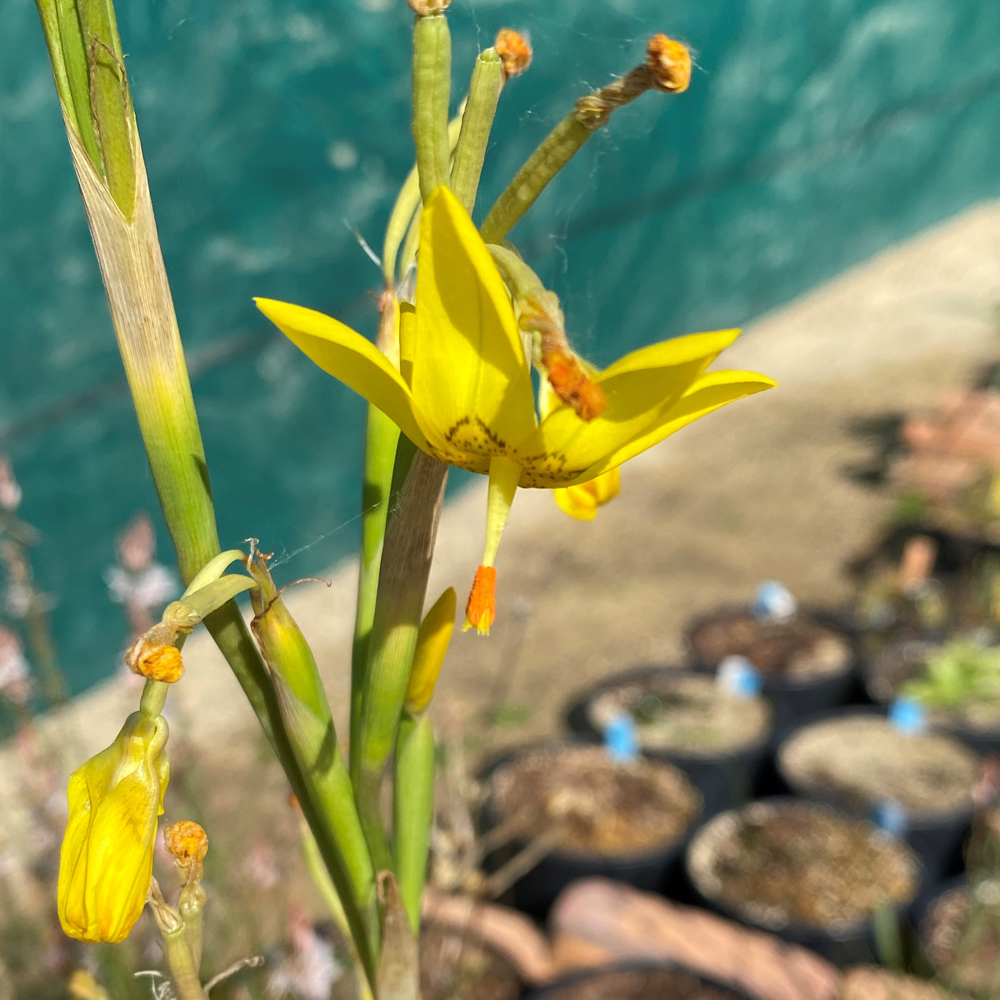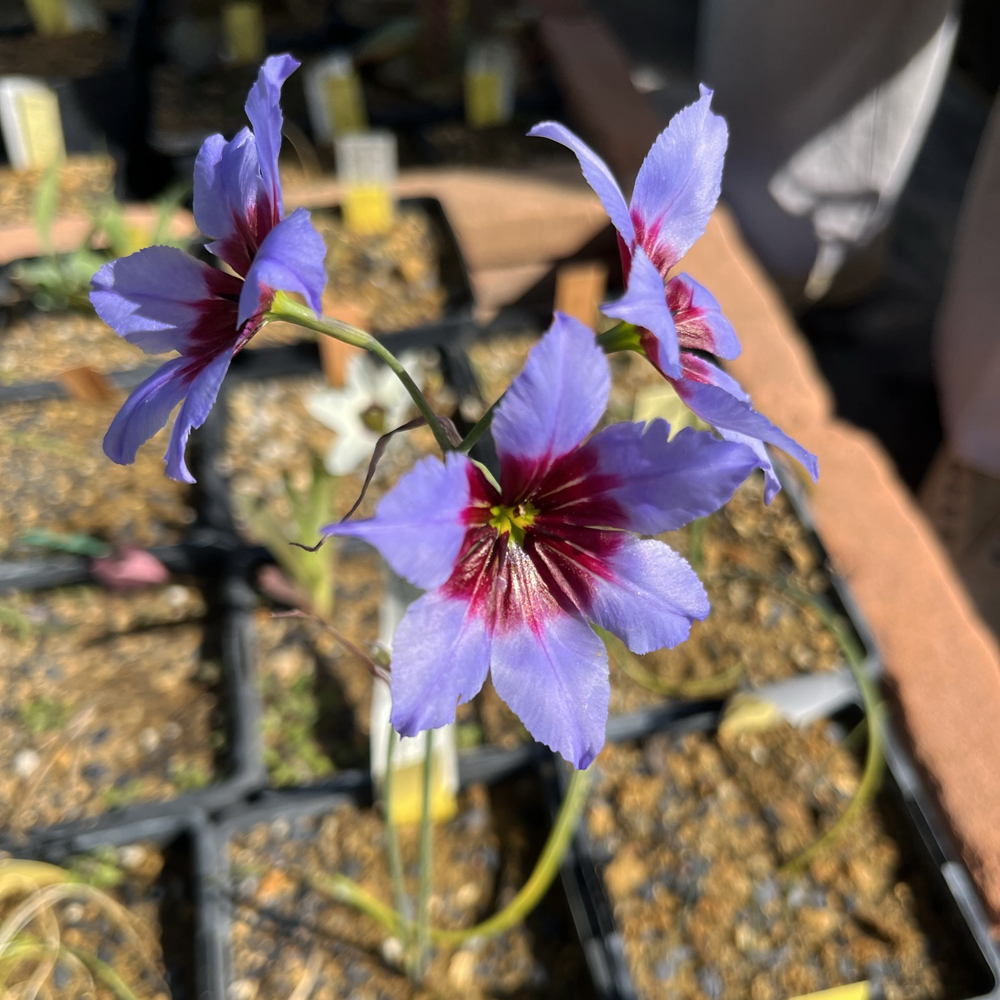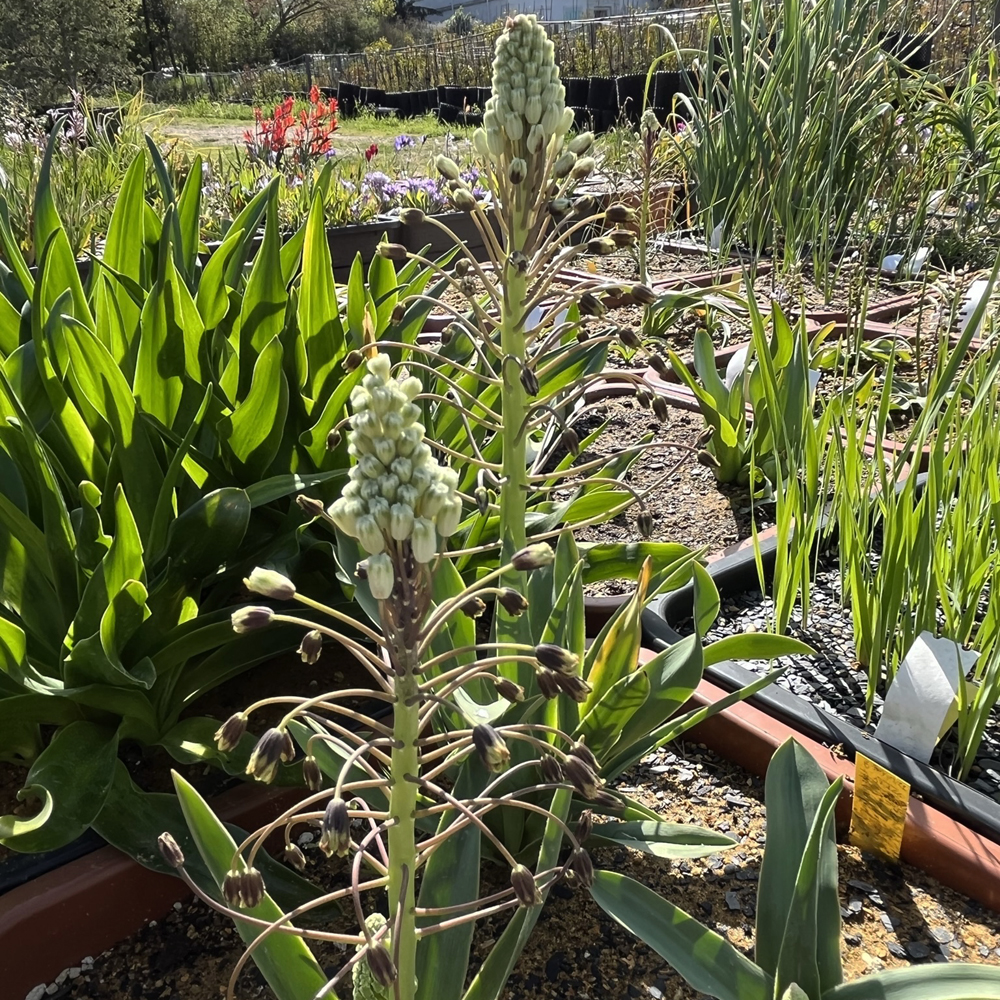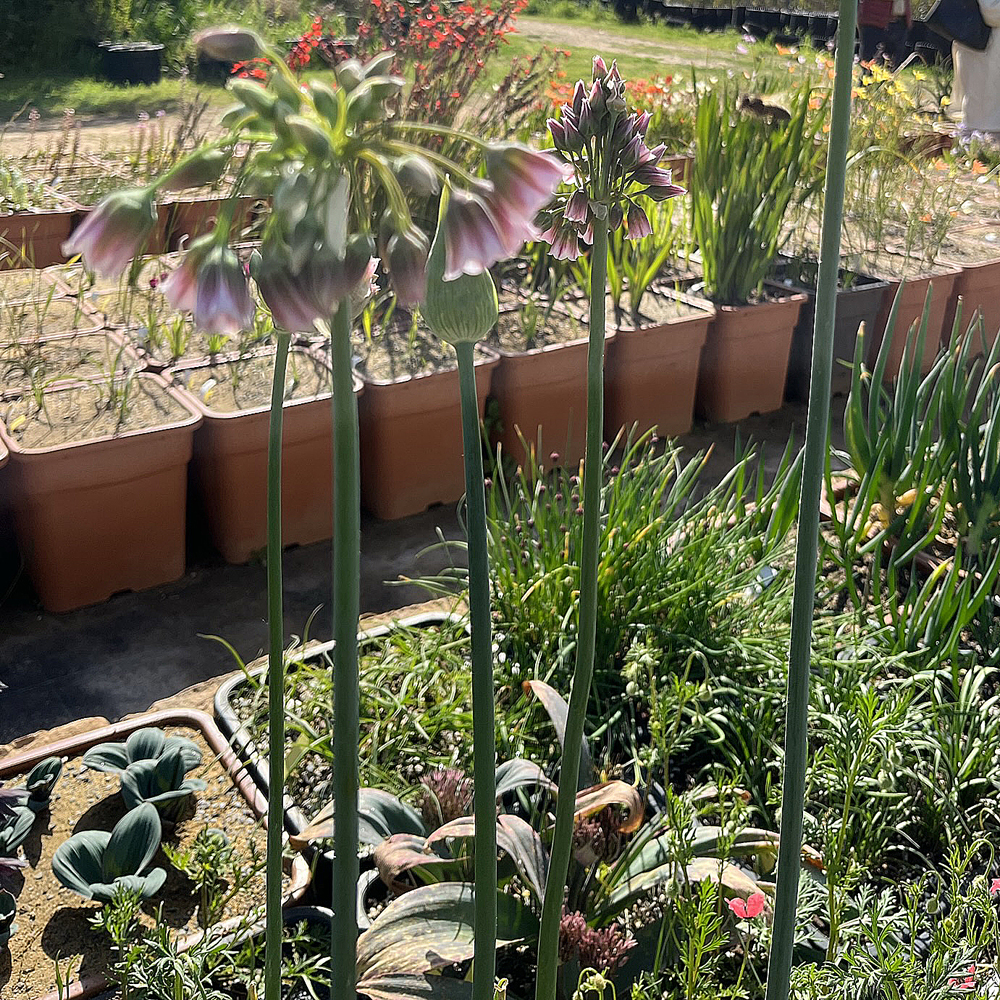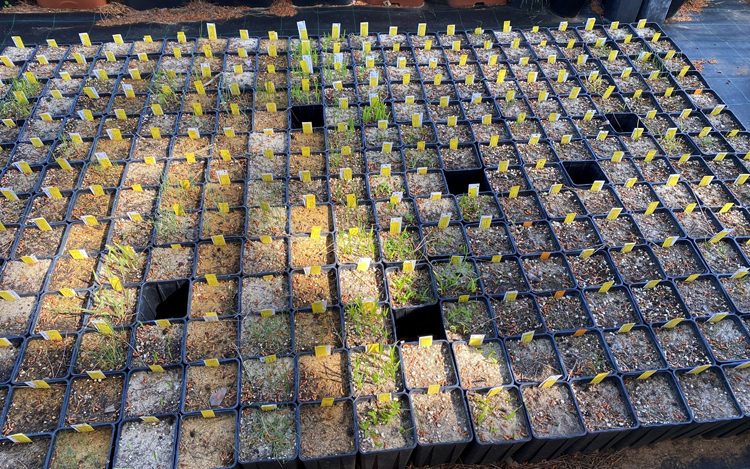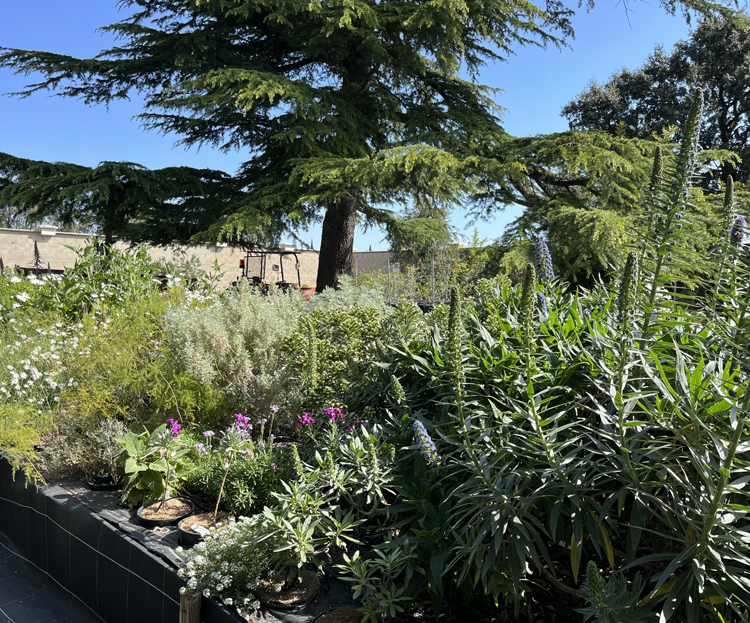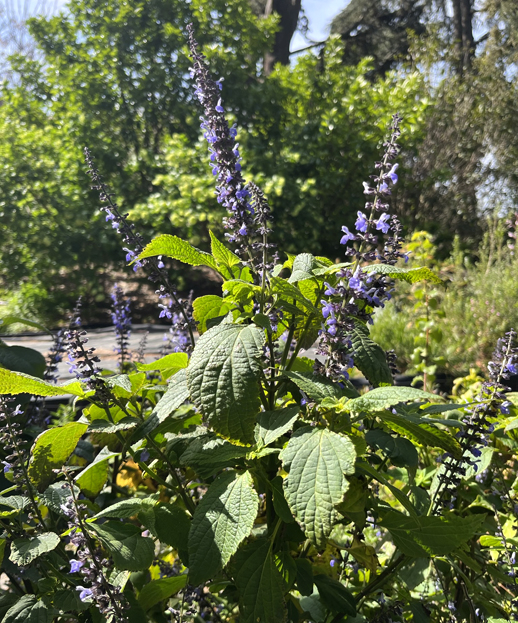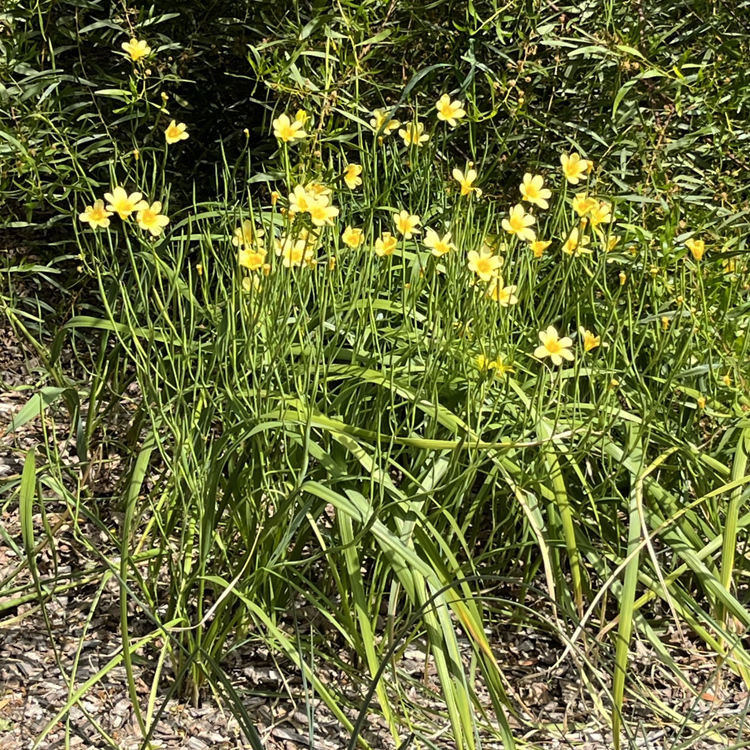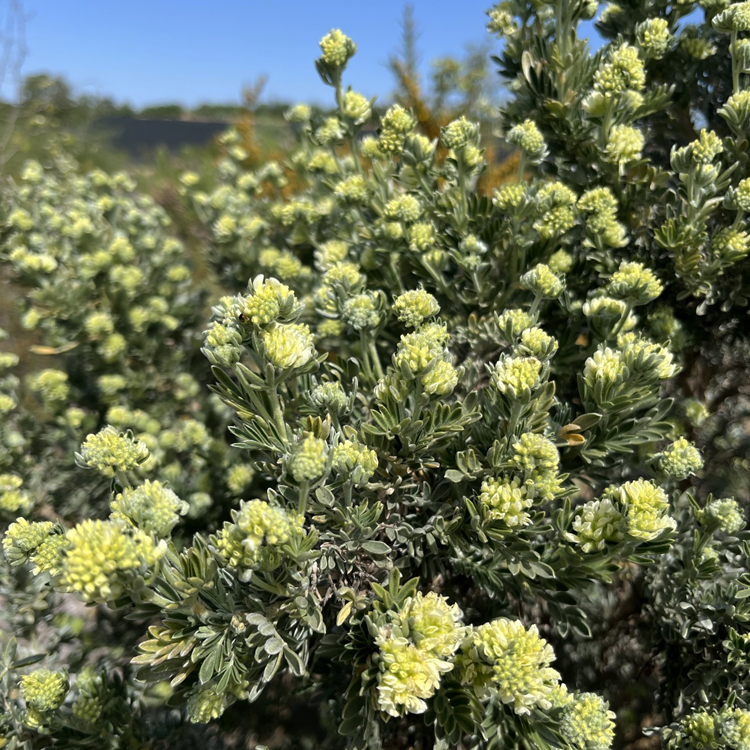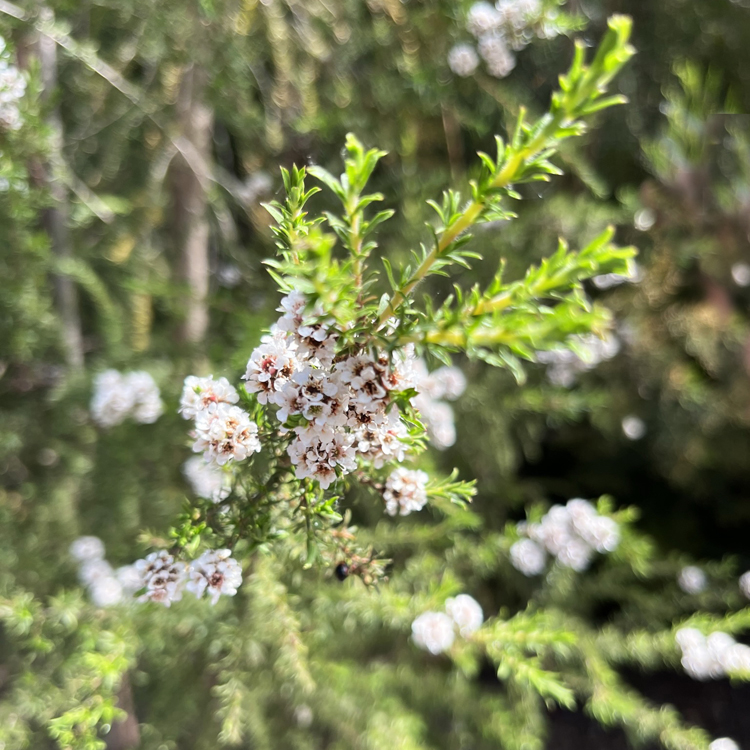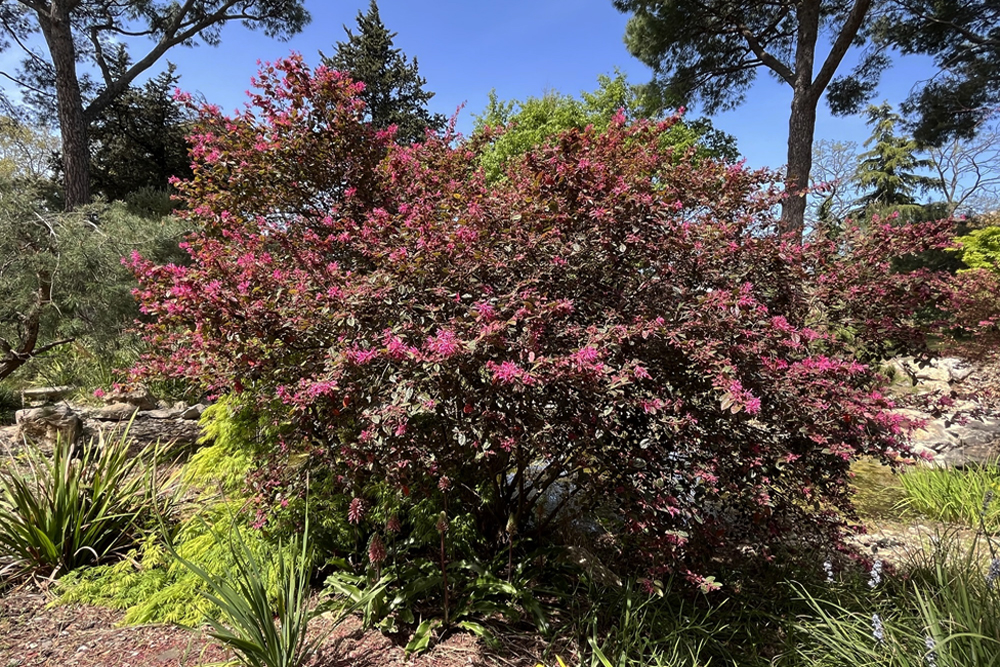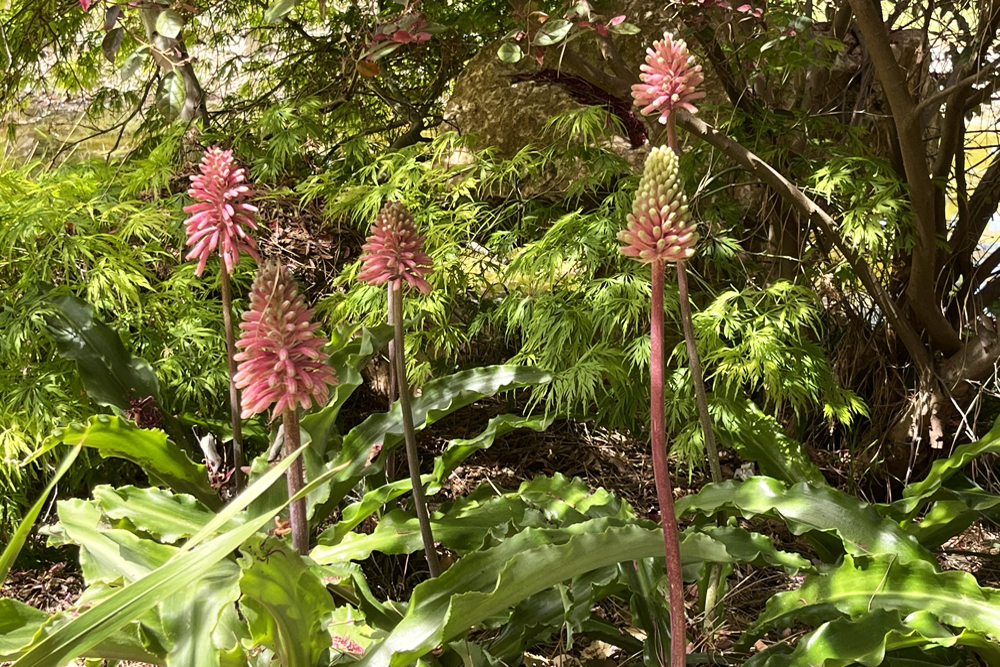Garden Diaries / Journaux de jardins
Château Pérouse
Château Pérouse, situated on the Plateau des Costières in the Gard, is home to an emerging botanical garden, featuring plants from the Mediterranean-climate regions of the world. The plant nursery was established in 2005, and four years later the first experimental gardens were created. This diary starts with an introduction by one of the owners, Jan-Willem Vos, and will be updated as the garden becomes established.
Château Pérouse, situé sur le plateau des Costières dans le Gard, héberge un tout nouveau jardin botanique, proposant des plantes des régions du monde entier à climat méditerranéen. La pépinière fut créée en 2005, et quatre ans plus tard, ce fut le tour des premiers jardins expérimentaux. Ce journal de bord commence par une introduction donnée par l’un des propriétaires, Jan-Willem Vos, et sera mis à jour au fur et à mesure de l’évolution du jardin.
Jan-Willem has generously donated around 500 types of seeds to the MGi Seed Collection.
Jan-Willem Vos a généreusement donné quelques 500 espèces de graines pour la Liste de Graines MGi.
Click on the images to enlarge them / Cliquez sur les images pour les agrandir
For the past fifteen years, an ambitious botanical project has been taking shape in an old wine estate in the Gard. The botanical garden already hosts four CCVS-labelled collections, but its originality is mainly due to the landscape treatment of this vast project, intended to provide the maximum of microbiota favourable to the acclimatisation of plants from all Mediterranean-climate regions of the planet – a sort of open-air biodome.
Depuis une quinzaine d’années, un projet botanique ambitieux prend forme dans un ancien domaine viticole du Gard. Il accueille déjà quatre collections labellisées CCVS, mais son originalité tient surtout au traitement paysager de ce vaste ensemble, destiné à fournir le maximum de micro biotopes favorables à l’acclimatation de plantes venues de toutes les régions à climat méditerranéen de la planète. Une sorte de biodôme à ciel ouvert.
The park is located on the Plateau des Costières in the commune of Saint-Gilles. On the outskirts of the château are magnificent cedars, more than a hundred years old, as well as other remarkable large trees planted in groups, as was common in the 19th century. The enhancement of the site is based on the endemic species of the region, extended by the creation of large areas referring to the different Mediterranean-climate areas of the world.
Le domaine du Château Pérouse se situe sur le plateau des Costières, sur la commune de Saint-Gilles. Aux abords du château se trouvent déjà de magnifiques cèdres plus que centenaires ainsi que d’autres grands sujets remarquables plantés en groupes comme c’était l’habitude au XIXe siècle. La mise en valeur du site s’appuie sur les espèces endémiques de la région et elle se prolonge par la création de grands espaces végétalisés faisant référence aux différentes parties du monde où se trouve le climat dit méditerranéen.
The plants in the botanical garden all come from areas with a Mediterranean-type climate, which is mainly characterised by hot and dry summers as well as mild and humid winters. However, many microclimates exist within these areas, and plants are very sensitive to them. To understand these needs better, we have relied on visits to the regions concerned and on bibliographical research which provides valuable information. We recreate all these microclimates in test gardens and then observe the reaction of the plants.
Les plantes installées dans le jardin botanique sont toutes issues de zones présentant un climat de type méditerranéen, qui se caractérise principalement par un été chaud et sec ainsi qu’un hiver doux et humide. Cependant, de nombreux microclimats existent au sein de ces zones, et les plantes y sont très sensibles. Pour mieux cerner ces besoins, nous nous appuyons sur les visites des régions concernées et sur des recherches bibliographiques qui donnent des indications précieuses. Nous recréons tous ces microclimats dans des jardins tests et nous observons ensuite la réaction des plantes.
To facilitate the acclimatisation of plants, a suitable landscape first needs to be created through, for example, the use of rocks, earth formations and the creation of artificial rivers. Compatible plant associations must then be formed, in particular by installing undergrowth plants beneath trees. In addition, as the soils vary in the different biotopes of origin, it is necessary to compose substrates which imitate them as closely as possible. Similarly, the quantity (frequency and intensity) and quality (pH control) of the irrigation needs to be adapted to the plants’ needs.
Pour faciliter l’acclimatation des plantes, plusieurs types d’actions sont possibles. Tout d’abord il convient d’aménager un paysage adapté, via l’utilisation d’enrochements, la formation de reliefs ou la création de rivières artificielles par exemple. Ensuite, il faut composer des associations végétales compatibles, notamment en installant les plantes de sous-bois sous des arbres et, à l’inverse, les plantes qui s’épanouissent en plein soleil bien l’écart de ceux-ci. De plus, comme les sols varient selon les biotopes d’origine, il faut composer des substrats les imitant au mieux. De même, l’irrigation doit être adaptée tant en quantité, fréquence et intensité, qu’en qualité : contrôle du pH, apport ou non d’engrais.
Sometimes more specific methods such as misting will be used to recreate the high humidity that is suitable for certain plants. These atmospheres and microclimates are tested for temperature, humidity, wind speed and solar radiation. Plant health is assessed by monitoring, by human observation and by measuring their chlorophyll content using a chlorophyll meter (SPAD502+ Konica Minolta) that does not damage the leaves. In addition, the amount of water used for irrigation will be measured in order to adjust it as accurately as possible.
Parfois des moyens plus spécifiques comme des brumisateurs seront employés pour recréer l’hygrométrie élevée qui convient à certaines plantes. Ces ambiances et microclimats sont testés à l’aide de capteurs de température, d’hygrométrie, de vitesse du vent et de rayonnement solaire… installés en différents points. La santé des végétaux est évaluée par un suivi régulier et une observation continue ainsi que par l’emploi d’un chlorophylle-mètre, le SPAD502+ de Konica Minolta qui permet de mesurer la teneur en chlorophylle sans détériorer les feuilles. Enfin, les quantités d’eau utilisées pour l’arrosage sont mesurées afin de pouvoir les ajuster le plus finement possible.
The layout designs are very meticulous and we are using our own software. In these designs coloured circles help to recognise the distribution of taxa, themselves designated by a number from the database. Attached to each number is all the necessary information to place each taxon in the drawing, including its size at the time of planting and also after 5, 10, 20 and 50 years. If we change the database content, the drawing will automatically change. The final goal is to provide a ‘natural’ landscape while mastering its development.
Les schémas d’implantation sont très méticuleux et évidemment réalisés sur ordinateur. La couleur des cercles aide à reconnaître la répartition des taxons, eux-mêmes désignés par un numéro issu de la base de données. À chaque numéro sont attachées toutes les informations nécessaires pour chaque taxon, par exemple sa taille au moment de la plantation ainsi qu’après cinq, dix, vingt et cinquante ans. Si nous en modifions le contenu, le plan se modifiera automatiquement. Le but final est de proposer un paysage « naturel » bien que maîtrisé quant à son futur développement.
Once the landscape has been modelled and the locations specified, it is time to focus on the plants. We work with specialist nurseries and seed suppliers, but despite this we remain vigilant about the veracity of the identification. On receipt of the plants, the taxa all get a label that they will keep for as long as they stay in the nursery. At the first flowering of a taxon, we take pictures and check the accuracy of the identification. These photos are then integrated into the database and provide confirmation of the plant’s identity.
Une fois le paysage modelé et les implantations précisées, il convient maintenant de s’intéresser aux plantes. Nous collaborons avec des pépinières et des fournisseurs de graines spécialisés, mais malgré cela nous restons vigilants sur la véracité de l’identification. À la réception des végétaux, les taxons obtiennent tous une étiquette qu’ils conserveront tant qu’ils resteront en pépinière. À la première floraison d’un taxon, nous prenons des photos et nous vérifions l’exactitude de l’identification. Ces photos sont ensuite intégrées dans la base de données et elles apportent la confirmation de l’identité.
In the gardens the taxa are geo-localized with a geometrical system (Total-Station Hilti, centimeter accuracy). Thus, we manage to merge the real and the virtual. With the help of a smartphone or a tablet connected to the website, the visitor can walk around to access the designs of the garden, zoom in and then click to obtain the document attached to each taxon. This information is much more complete than on a conventional label and is available in three languages. It can be found on the online database of the Château Pérouse website.
En jardin test, une fois plantés, les taxons sont géolocalisés avec le système de géomètre Total-Station de Hilti, à la précision centimétrique. Ainsi, nous parvenons à fusionner le réel et le virtuel. Avec l’aide d’un smartphone ou d’une tablette connectée sur le site internet, le visiteur peut en se promenant accéder aux plans du jardin, zoomer puis cliquer pour obtenir le document attaché à chaque taxon. Cette information plus complète que sur une étiquette classique est disponible en trois langues. On la retrouve sur la base de données en ligne du site internet du Château Pérouse.
Good acclimatisation begins from the moment of sowing. Once the seeds have been obtained fromspecialists from all over the world, some of them are entrusted to specialist nurseries such as Arven, Issa, Railhet, Cavatore and Le Monde des Fougères. These seeds are germinated in their greenhouses. Nevertheless, the large majority of the seeds are sown by us in our own greenhouses or in our growing chamber (3,500 taxa per year from 2018 onwards). We adapt the growing medium to the soil composition of the landscape in order to create continuity for the plants when they are planted out. As soon as the plants are resistant enough, they pass into acclimatisation greenhouses where they grow on further, after which they are planted in test gardens.
Une bonne acclimatation commence dès le semis. Une fois les graines obtenues auprès des spécialistes repérés dans le monde entier, une partie est confiée à des pépinières spécialisées comme les pépinières Arven, Issa, Railhet, Cavatore et le Monde des Fougères. Celles-ci assurent la mise en germination sous serre. Tout le reste des graines est semé par nos soins dans les serres ou encore dans notre chambre de culture. Dès que les plantes sont suffisamment résistantes, elles passent dans les serres d’acclimatation et parfois sous voile d’ombrage, le temps qu’elles grandissent davantage avant de les installer dans les jardins tests.
From 2009 onwards we created four test gardens which now form the visitable part of the botanical gardens.
Depuis 2009, nous avons créé quatre jardins d‘expérimentation qui constituent maintenant la partie visitable des jardins botaniques.
The first one was dedicated to discovering all the plants we could maintain in the garden. We acquired a lot of information about the possibilities for some plants as well as the knowhow we needed in order to create better conditions for many others. One of the major elements was a good soil mixture since on site we have red clay. We tried adding a lot of sand and small pebbles, but to no avail. Of the two thousand taxa tested, only 287 remain in this garden today.
Le premier était dédié à la découverte des plantes que nous pourrions acclimater dans le jardin. Nous avons acquis de nombreuses données sur les capacités d’adaptation de certaines plantes ainsi que le savoir-faire nécessaire pour créer de meilleures conditions pour beaucoup d’autres. Un des paramètres majeurs était une bonne composition des sols car notre terrain est fait d’argile rouge. Nous avons essayé d’ajouter beaucoup de sable et de petits cailloux, mais en vain. Sur les deux mille taxons testés, seuls 287 ont survécu dans ce jardin aujourd’hui.
The second test garden was developed for Australian plants. In this garden we have tested new substrates with very good drainage. The benefits were apparent straight away. The soils are much more like Australian soils and even the plants’ frost hardiness has improved vastly since there is no waterlogging.
Le second jardin d’expérimentation a été développé pour les plantes australiennes. Dans ce jardin, nous avons testé de nouveaux substrats avec un très bon drainage. Les avantages ont été immédiatement visibles. Les sols s’apparentent beaucoup plus aux sols australiens et même la résistance au gel des plantes s’est considérablement améliorée car il n’y a pas de stagnation d’eau.
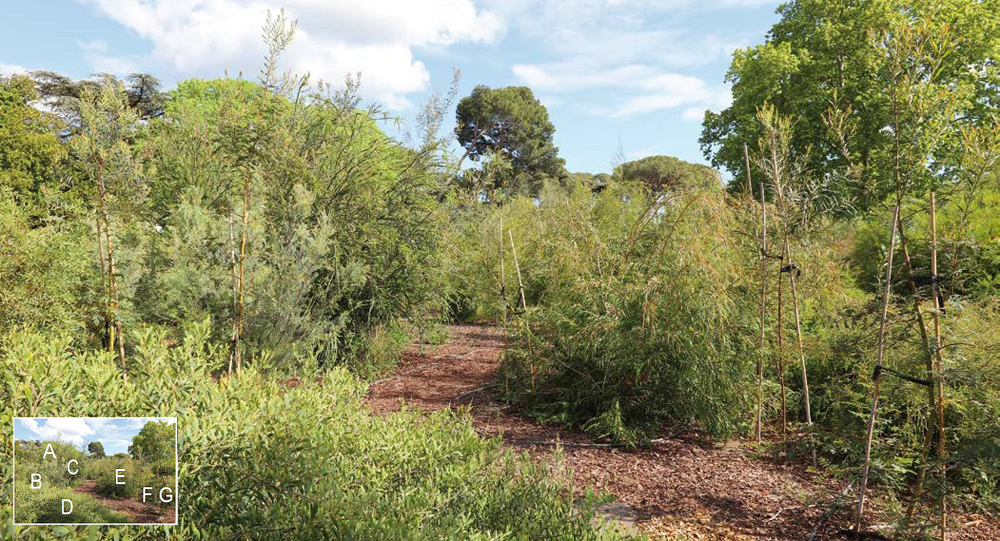
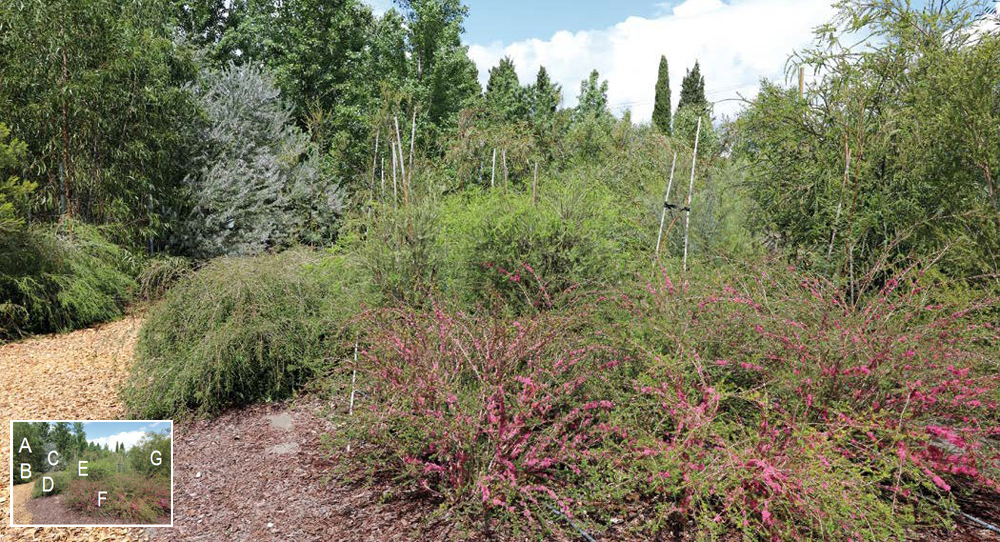
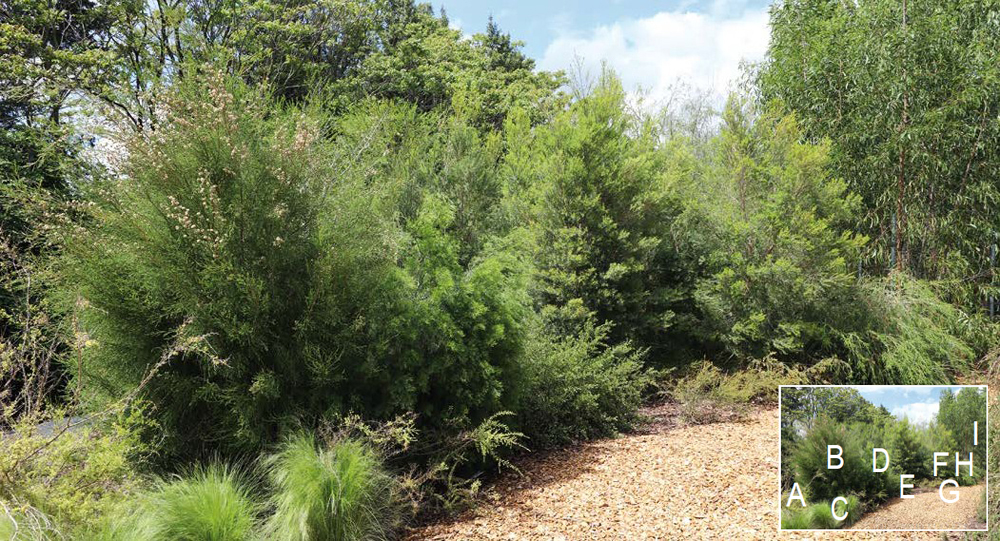
The third test garden was developed for low chaparral / garrigue-type biomes of the four continents. In this garden we used a different substrate with 60% of pouzzolane. After two years the results are as good as those of the first garden with the possibility of a better coherence of the soil when replanting. We are testing more and more plant communities here.
Le troisième jardin d’expérimentation a été développé pour les biotopes de type chaparral / garrigue de basse altitude de quatre continents. Dans ce jardin, nous avons utilisé un substrat différent avec 60% de pouzzolane. Après deux ans les résultats sont aussi bons que ceux du premier jardin et cela permet une meilleure consistance du sol lors de la replantation. Nous y testons de plus en plus d’associations végétales.
Parts of the river garden have been turned into a South African grassland as well as testing for understory plants from South African forests. Here we see research into substrates and plant communities coming together with the work we are doing on geophytes and succulents. In the coming years we shall be improving this part until we have a landscape with grasses and flowers the whole year round.
Certaines parties du jardin de la rivière ont été transformées en prairie sud-africaine et en jardin d’expérimentation pour des plantes de sous-étage des forêts sud-africaines. Ici, nous voyons notre recherche sur les substrats et les associations de plantes converger avec le travail que nous faisons sur les géophytes et les plantes succulentes. Dans les années à venir, nous améliorerons cette partie jusqu’à obtenir un paysage avec des graminées et des fleurs toute l’année.
Next steps
We shall need another four years of cultivation and the creation of 25 acres of test gardens before weare able to start planting the first phase of the ultimate botanical gardens. The next test garden will have as its objective the creation of all the microclimates for the project. The advantage of having microclimates of known quality is that it helps us to assess the best acclimatisation for each taxon while also assessing the invasiveness of each taxon.
Prochaines étapes
Il nous faudra encore quatre ans de culture et créer 25 acres de jardins d’expérimentation avant de pouvoir commencer la phase ultime de plantation des jardins botaniques. Le prochain jardin d’expérimentation aura pour objectif la création de tous les microclimats nécessaires au projet. L’avantage d’avoir des microclimats de qualité connue est que cela nous aide à évaluer la meilleure façon d’acclimater chaque taxon tout en évaluant le caractère invasif de chacun.
For more information you can visit the website at chateau-perouse.com where you will also find an extensive database (more than 18,000 taxa). The database is used by our botanists and provides general information from our library. It provides links to an html-page per taxon including the germination information, the history of our experience with the taxon and little by little other information and photographs.
Pour plus d’informations, vous pouvez visiter le site Web à chateau-perouse.com où vous trouverez également une vaste base de données (plus de 18 000 taxons). La base de données est utilisée par nos botanistes et fournit des informations générales. Elle fournit des liens vers une page html par taxon comprenant les informations de germination, l’historique de notre expérience avec le taxon et, petit à petit, d’autres informations et photographies.
Text: Jan-Willem Voss
Photos: Château Pérouse
The owner, Jan-Willem Voss, welcomed us and gave us a description of the botanical park of Château Pérouse and of his project.
Le propriétaire des lieux Jan-Willem Voss nous accueille et nous présente le parc botanique de Château-Pérouse et son projet.
Greenhouses
We split into two groups guided by two botanist-gardeners, one specialising in ferns and the other in bulbous plants.
Les serres
Nous nous divisons en deux groupes guidés par deux botanistes-jardiniers, l’un spécialiste des fougères et l’autre des plantes à bulbes.
Once the seeds have been obtained, they are sown on site or delegated to specialised nurseries. As soon as the plants are strong enough, they are placed in one of the ten acclimatisation greenhouses, and then in the experimental gardens where they are tested under various conditions. Usually about 15 specimens of each species are tested in groups of three, subject to five different conditions.
Une fois les graines obtenues, elles sont semées sur place ou confiées à des pépinières spécialisées. Dès que les plantes sont suffisamment résistantes, elles passent dans une des dix serres d’acclimatation, puis dans les jardins d’expérimentation où elles sont testées en diverses conditions. En général, une quinzaine d’exemplaires de chaque espèce sont testés par groupe de trois dans cinq conditions différentes.
In the fern greenhouse, 150 plants were sown this year, in addition to the 150 which had previously been selected and tested. Particular attention is paid to xerophilic species from hot and dry regions of North America, Australia and South Africa. Their hairy fronds or scaled stems allow them to retain moisture and be resistant to the heat of the sun. The genera Myriopteris and Cheilanthes can be cultivated in the Mediterranean. Doodia media is resistant to limestone and has beautiful reddish fronds.
Dans la serre des fougères, 150 ont été semées cette année, en plus des 150 déjà sélectionnées et testées. Une attention particulière est portée aux espèces xérophiles venant de régions chaudes et sèches d’Amérique du nord, d’Australie et d’Afrique du Sud. Leurs frondes poilues ou des tiges portant des écailles leur permettent de retenir l’humidité et de résister au soleil. Les genres Myriopteris, Cheilanthes peuvent être cultivés en Méditerranée. Doodia media résiste au calcaire et possède de belles frondes rougeâtres.
The succulent greenhouse also has a large number of species, 85% of which were obtained from seed. We were intrigued by the strange shapes of Euphorbia clava, Albuca spiralis and Lithops sp..
La serre des succulentes présente aussi un grand nombre d’espèces dont 85% ont été obtenues par semis. On admire les formes étranges des Euphorbia clava, Albuca spiralis et Lithops sp..
Shade sail and experimental gardens
The plants are then placed under a shade sail to continue their growth. Many are grown in air-pots. These pots, originally developed for the cultivation of eucalyptus in Australia, are circular in shape, and consist of a perforated wall with closed cones on the inside and open cones on the outside. The cones on the inside channel the roots and lead them to the open cones on the outside. As they move outwards, the tips of the roots become dehydrated and wither away. This air-pruning process allows the plant to form many more knot-free roots.
Voile d’ombrage et jardins d’expérimentation
Les plantes sont ensuite placées sous un voile d’ombrage pour continuer leur croissance. Beaucoup sont cultivées en air-pot. Ces pots développés à l’origine pour la culture des Eucalyptus en Australie, sont de forme circulaire, ils sont constitués d’une paroi perforée avec des cônes fermés à l’intérieur et des cônes ouverts à l’extérieur. Les cônes de l’intérieur canalisent les racines et les conduisent vers les cônes ouverts de l’extérieur. En arrivant vers l’extérieur les pointes des racines se déshydratent et se coupent. Ce processus de taille par l’air permet à la plante de former beaucoup plus de racines sans faire de chignons.
The plants are then placed in the experimental garden, where they are tested under various growing conditions. They are geo-localized to the accuracy of a centimeter. The experimental garden is divided into distinct sectors which correspond to the five continents. For each taxon tested, the systematic analysis of the different climatic and geological growing conditions ultimately results in a large database in which detailed information on the plants is collected.
Les plantes sont ensuite installées dans les jardins d’expérimentation où sont testées diverses conditions de culture. Elles y sont géo localisées au centimètre près. Cinq secteurs correspondants aux cinq continents sont délimités. Pour chaque taxon testé, l’analyse systématique des différentes conditions de culture climatiques et géologiques aboutit au final à une vaste base de données où sont collectées les informations détaillées sur les plantes.
River garden
The visit ended with the highlight of the show: a garden which demonstrates that a systematic and scientific botanical approach can also allow the creation of a landscaped garden of great beauty. Designed by Jan-Willem Voss with the help of the botanists, it is planted with centuries-old trees such as stone pines and Aleppo pines, cypresses, as well as cedars from the Atlas, Lebanon and the Himalayas. It is structured around an artificial river 130 m long with a series of ponds, waterfalls and rapids offering different viewpoints and perspectives. In this way, different plant environments are developed and controlled, while creating the illusion of a ‘natural‘ landscape.
Jardin de la rivière
La visite se termine par le clou du spectacle qui démontre qu’une démarche botanique systématique et scientifique peut aussi permettre de créer un jardin paysager d’une grande beauté. Ce jardin dessiné par Jan-Willem Voss avec l’aide des botanistes est planté d’arbres centenaires tels que des pins parasol et d’Alep, des cyprès, ainsi que des cèdres de l’Atlas, du Liban et de l’Himalaya. Il s’organise autour d’une rivière artificielle de 130 m de long avec une alternance de plans d’eau, de cascades et rapides offrant différents points de vue et perspectives. Ainsi sont réalisées différentes ambiances végétales formant un paysage « naturel » bien qu’entièrement maîtrisé.
Our visit ended with a picnic in the shade of the tall trees.
Notre visite s’achève par un pique-nique sous les grands arbres.
Text: Chantal Guiraud and Roland Leclercq
Photos: Liliane Leclercq, Hugues Pelen, Hubert Nivière, Chantal Guiraud, Château Pérouse
The focus on this visit was the geophyte collection, grown neatly in closely stacked rows of large square pots, sheltered by old flat bricks from a tumbledown wall on the property.
Cette visite était basée sur la collection de géophytes, cultivée avec soin en rangées étroites de grands pots carrés, abrités par de vieilles briques plates provenant d’un mur écroulé de la propriété.
Johan Willm presented the stunning collection of plants, starting with those originating from South Africa, mainly the Western Cape. While the climate of the Western Cape is similar to our own, with winter rains and long dry periods in summer, in Mediterranean France frost can be a problem, as can too much heat on the plastic pots in the summer, hence the protective bricks. The geophytes in pots will be used as ‘mother’ plants from which to collect seeds to propagate plants for the garden.
Johan Willm nous a présenté l’étonnante collection de plantes, en commençant par celles originaires d’Afrique du Sud, principalement du Cap occidental. Si le climat du Cap occidental est similaire au nôtre, avec des pluies hivernales et de longues périodes sèches en été, en France méditerranéenne, le gel peut être un problème, tout comme une chaleur trop importante sur les pots en plastique en été, d’où les briques de protection. Les géophytes en pots servent de plantes ” mères ” à partir desquelles on récoltera des graines pour multiplier les plantes du jardin.
Lachenalia are small bulbous plants endemic to South Africa and Namibia and the Chateau Perouse collection includes 74 species types. In the south of France, many species are easy to cultivate and offer a colourful show from early autumn to late spring. There is an article on lachenalia by Johan Willm in the Plants section of the website. Other South African bulbs we admired included species of Babiana, Romulea, Sparaxis, Ixia and Moraea.
Les Lachenalia sont de petites plantes bulbeuses endémiques d’Afrique du Sud et de Namibie. La collection du Château Pérouse comprend 74 espèces. Dans le sud de la France, de nombreuses espèces sont faciles à cultiver et offrent un spectacle coloré du début de l’automne à la fin du printemps. Vous trouverez un article de Johan Willm sur les lachenalia dans la section Plantes du site. Parmi les autres bulbes sud-africains que nous avons admirés figurent des espèces de Babiana, Romulea, Sparaxis, Ixia et Moraea.
Bulbs from other Mediterranean climate areas included Leucocoryne purpurea, from Chile, a plant well adapted to cold conditions, Bellevalia sarmatica from the Eastern Mediterranean and Allium siculum, native to Southern Europe and Turkey.
Parmi les bulbes provenant d’autres régions à climat méditerranéen, citons Leucocoryne purpurea, du Chili, une plante bien adaptée aux conditions froides, Bellevalia sarmatica de la Méditerranée orientale et Allium siculum, originaire d’Europe du Sud et de Turquie.
Another very important consideration for these bulbous plants is the substrate – something which the team has been working on for years. Their most recent recipe includes a beautiful sharp, quite rough grained sand from the Loire.
Une autre considération très importante pour ces plantes bulbeuses est le substrat – un point sur lequel l’équipe travaille depuis des années. Leur recette la plus récente comprend un beau sable à grain assez grossier provenant de la Loire.
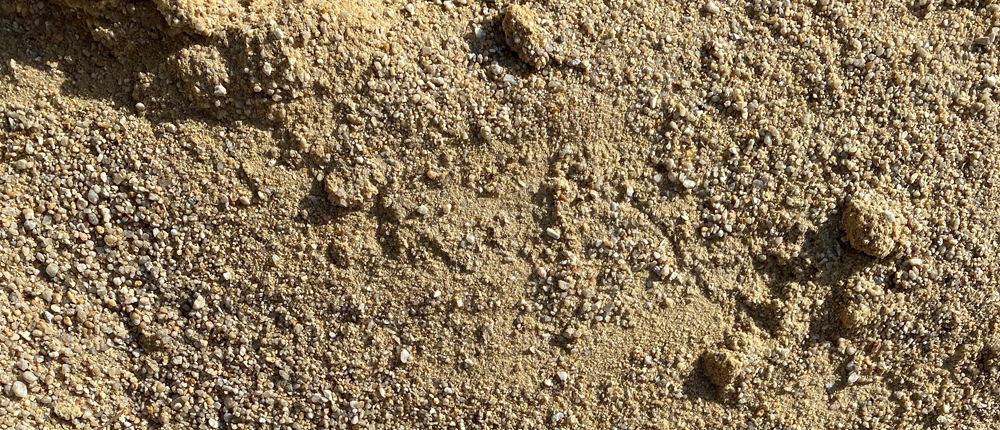
With Johan we moved on to the seed plant area, in the shade of some of the ancient cedars. Seeds are sown in classic 1.4 litre tall square pots in September, and now in April were beginning to sprout. The seedlings are not given the dormancy required by adult plants but irrigated regularly throughout the summer. At this stage in their development summer watering will not cause the bulbs to rot, whereas watering is to be avoided when the bulbs become bigger. Once again, the pots are arranged in closely stacked rows to provide maximum shelter.
Avec Johan, nous nous sommes dirigés vers la zone de semis, à l’ombre de quelques vieux cèdres. Les graines sont semées en septembre dans des pots carrés classiques de 1,4 litre, et elles commencent à germer maintenant, en avril. Les semis ne bénéficient pas de la dormance requise par les plantes adultes mais sont irrigués régulièrement tout au long de l’été. À ce stade de leur développement, l’arrosage estival ne provoquera pas la pourriture des bulbes, alors que l’arrosage est à éviter lorsque les bulbes deviennent plus gros. Une fois encore, les pots sont disposés en rangs serrés pour offrir un abri maximal.
Nearby are some beds where plants from different climate zones are being tried out. Echiums were coming into flower in the Canary Islands bed and the early-flowering Salvia roscida, from Mexico, was in full bloom.
A proximité, se trouvent des parterres où sont testées des plantes provenant de différentes zones climatiques. Les échiums commençaient à fleurir dans le parterre des îles Canaries et la Salvia roscida, originaire du Mexique, était en pleine floraison.
With Jan Willem Vos, we then visited the polytunnels. Chateau Pérouse holds important collections (Collections Agrées CCVS) of Melaleuca and Podocarpus, and National Collections (Collections Nationales CCVS) of Acacia and Eucalyptus all grown from seed in the nursery, there are also polytunnels full of succulents, again growing from seed. All are eventually destined to be planted in the botanical garden.
Avec Jan-Willem Vos, nous avons ensuite visité les polytunnels. Le Château Pérouse possède d’importantes collections (Collections Agrées CCVS) de Melaleuca et Podocarpus, et des Collections Nationales CCVS d’Acacia et Eucalyptus, toutes cultivées à partir de graines dans la pépinière. Il y a aussi des polytunnels remplis de plantes succulentes, également cultivées à partir de graines. Toutes ces plantes sont finalement destinées à être plantées dans le jardin botanique.
Next, we strolled through the experimental gardens set up to see how plants adapt to various types of growing conditions. The eucalyptus forest is becoming more mature, with under-story plants now being tried out. Yellow fritillaries were looking comfortable in their positions, as were Anthyllis barba-jovis and Taxandria juniperina.
Ensuite, nous nous sommes promenés dans les jardins expérimentaux mis en place pour voir comment les plantes s’adaptent à différents types de conditions de croissance. La forêt d’eucalyptus devient plus mature et les plantes de sous-bois sont maintenant testées. Les fritillaires jaunes semblaient à l’aise dans leurs positionnements, tout comme l’Anthyllis barba-jovis et le Taxandria juniperina.
Finally, the River Garden, wonderfully landscaped and full of mature plants, a beautiful area which provides a home for wildlife as well as plants. In particular, the deep pink flowers of Loropetalum chinense with an under planting of Veltheimia bracteata were much admired.
Enfin, le Jardin de la Rivière, merveilleusement aménagé et rempli de plantes matures, est une belle zone qui abrite aussi bien la faune que la flore. En particulier, les fleurs rose foncé du Loropetalum chinense en association avec quelques Veltheimia bracteata ont été très admirées.
Text and photographs: Sandra Cooper and Christine Daniels
![]()

